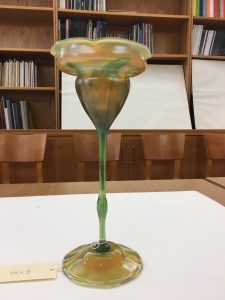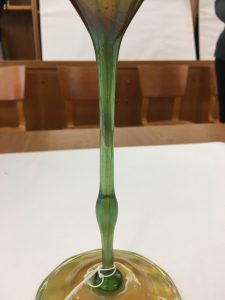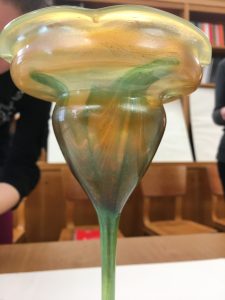I was attracted to Louis Comfort Tiffany’s Flower Form because of the manipulation of color and pigments seen throughout the glassware. He creates movement in a stagnant piece through the use of color, and the ways in which they interact with each other and the glass itself. Tiffany’s Flower Form is a vertical glassware that emulates the shape of a flower, with a stem and base, yet lacks other elements of a flower such as individual petals and leaves (Figure 1). The glassware stands on a yellow base that appears to be connected to the stem, bonded either by melting or with the use of an adhesive. The distinct separation of colors between the green stem and yellow base indicate that these two elements were probably not made as one piece. The base of the glassware is a circular form that was pulled while still hot, allowing Tiffany to take advantage of the malleability of glass while still in a liquid phase. The stem and the head of the flower are most likely composed of the same glass tube. This portion of the glassware was a result of glass blowing, in which the glass would have been stretched and blown to the desired shape while hot. The stem of the glass would have been stretched with tweezers in order to achieve such length and thinness (Figure 2). The head of the glassware probably required the most manipulation and time in order to increase the diameter of the glass that was used. The lowest portion of the head, also the most bulbous, appears to have been gradually stretched out from the stem, perhaps making the process easier for Tiffany as he pulled the liquid glass. The head then experiences another dip, which is uniform all around the piece, indicating that it was pressed down while the glass was being turned. The top portion of the piece also appears to be pulled, yet instead in a flattening manner. The glassware experiences an abrupt change in its diameter, where it flowers out, and opens up at the top of the piece.

Flower Form is characterized by various elements that come together to produce a floral shape, which is further seen in how Tiffany uses color to unify the different components. The shifts in yellow to green and back to yellow again allow the colors to interact with each other. The embedded color in the glass indicate that colored metals or pigments were most likely added to the glass while still in the liquid form, which would enable the color to be a part of the glass as it cooled. The base of the piece experiences a shift in the change of color from a paler yellow to a darker yellow-orange. The color difference also produces a change in the translucency of the glass, with the darker yellow-orange being more opaque than the yellow, which could have been achieved with the use of greater amounts of metals or pigment. The stem of the glassware is a green color, with varying opacities, and with darker hues at the top of the stem (Figure 2). Also visible are vertical lines that imitate the veins of a flower, again varying in shades. Perhaps the most intriguing color change is found where the stem meets the head of the flower. Here, the green and the orange interact between lines and movement that appear to follow the movement of the glassware (Figure 3). The lines and the way that the color moves upward in the piece could be a result of applying the pigment prior to pulling. Tiffany may have first pulled the glass around the general shape, then added the pigment, after which he stretched it to the final shape, which exposed the lines found between the colors. Tiffany’s manipulation of the metals and pigments to create movement in the piece is enhanced by the addition of an iridescent finish. This finish may have been a result of additional metals that were added after the pigment was added, and contributes a glowing quality to the rest of the piece (Figure 3).


Tiffany’s Flower Form takes advantage of the flexibility of glass while it is in the liquid phase, the lettuce-esque edges of the base and flower head provide movement caused by pinching, while the slender stem was pulled to the desired length. It provides color to the piece that play with the chemical properties of glass, while the addition of the iridescent metals enhances the glossy finish that one typically associates with glass works.